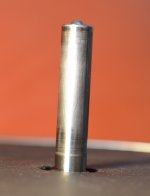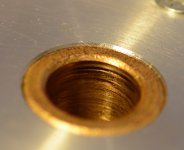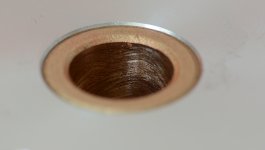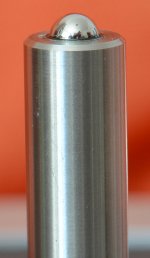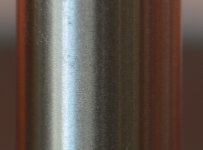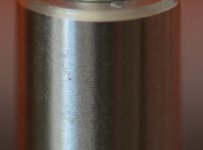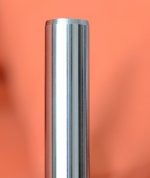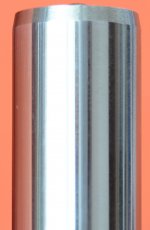Some time ago i became the proud owner of a used Acoustic Signature bearing/platter assembly.
Proud does not necessarily imply happy as the bearing was damaged beyond belief.
Fortunately the seller turned out to be extremely patient and understanding and kind and at the end the monetary loss was quite moderate.
As can be seen from the pics, the bearing probably ran dry for an extended period of time. Not sure how this could have happened as it is sold as a "maintenance free" item with a 10 year warranty.
The design is not too dissimilar to other well known bearings. The Thorens 124 being a good example.
A steel spindle is press fit into an aluminium platter. There is a captive tungsten ball at the end and a tidorfolon bearing surface underneath. An aluminium bearing housing contains two sintered bronze bushings.
Proud does not necessarily imply happy as the bearing was damaged beyond belief.
Fortunately the seller turned out to be extremely patient and understanding and kind and at the end the monetary loss was quite moderate.
As can be seen from the pics, the bearing probably ran dry for an extended period of time. Not sure how this could have happened as it is sold as a "maintenance free" item with a 10 year warranty.
The design is not too dissimilar to other well known bearings. The Thorens 124 being a good example.
A steel spindle is press fit into an aluminium platter. There is a captive tungsten ball at the end and a tidorfolon bearing surface underneath. An aluminium bearing housing contains two sintered bronze bushings.
Attachments
So, after some head-scratching and talking to people who know this stuff i decided against diy repairs or attempting to reuse the platter with a different bearing.
The factory in Germany offered to either sell me a new bearing or replace it themselves. The procedure of removing and refitting the bearing did not sound too appealing and so it went back to the factory.
A new spindle was press-fit and a new matching housing was also manufactured. The old spindle apparently got damaged in the process of being removed.
Well, it came back and much to my horror turned out to be nearly as noisy as the old damaged one. When the platter spins noise can easily be heard a meter away. Or two.
The factory assured me the noise will get better after it spins for a while. And it probably will.
Will it become silent enough for use in a high quality turntable? I don't know.
For one, the spindle looks mat, rather than polished. Tool marks are seen all over. The bushings - well, there is a picture provided. Turns out spindle pictures are not easy to take, especially without dedicated lighting but one can still get the idea.
As for the bushings, my understanding is that one should aim for the correct size by design. Machining may easily reduce the porosity of the sintered bronze and reduce lubrication. This probably explains why the bushings look the way they do - they were machined using some appropriate tool. It also hints at the reason the original bearing self-destructed, but not being the original owner i can only speculate why it died so young.
And as a rather ironic comparison i also include a pic of my Thorens 124 spindle. Not sure about the exact age but has certainly passed its 50-th birthday.
Unlike the Acoustic Signature, the Thorens spindle looks mirror polished and is extremely smooth to touch. Because of the reflections it also much harder to photograph.
Dunno what to make out of this. Not being a machinist or a mechanical engineer i don't know much about these things. Maybe the new bearing will polish itself after working for a couple of thousand hours. Maybe it will self-destroy. Maybe the noise doesn't matter and the tight tolerances are all important. Maybe in the middle of summer there was only an apprentice left running the lathe...
The factory in Germany offered to either sell me a new bearing or replace it themselves. The procedure of removing and refitting the bearing did not sound too appealing and so it went back to the factory.
A new spindle was press-fit and a new matching housing was also manufactured. The old spindle apparently got damaged in the process of being removed.
Well, it came back and much to my horror turned out to be nearly as noisy as the old damaged one. When the platter spins noise can easily be heard a meter away. Or two.
The factory assured me the noise will get better after it spins for a while. And it probably will.
Will it become silent enough for use in a high quality turntable? I don't know.
For one, the spindle looks mat, rather than polished. Tool marks are seen all over. The bushings - well, there is a picture provided. Turns out spindle pictures are not easy to take, especially without dedicated lighting but one can still get the idea.
As for the bushings, my understanding is that one should aim for the correct size by design. Machining may easily reduce the porosity of the sintered bronze and reduce lubrication. This probably explains why the bushings look the way they do - they were machined using some appropriate tool. It also hints at the reason the original bearing self-destructed, but not being the original owner i can only speculate why it died so young.
And as a rather ironic comparison i also include a pic of my Thorens 124 spindle. Not sure about the exact age but has certainly passed its 50-th birthday.
Unlike the Acoustic Signature, the Thorens spindle looks mirror polished and is extremely smooth to touch. Because of the reflections it also much harder to photograph.
Dunno what to make out of this. Not being a machinist or a mechanical engineer i don't know much about these things. Maybe the new bearing will polish itself after working for a couple of thousand hours. Maybe it will self-destroy. Maybe the noise doesn't matter and the tight tolerances are all important. Maybe in the middle of summer there was only an apprentice left running the lathe...
Attachments
The new shaft is made from the same steel. It is just brand new. In order to avoid confusion, the last two pics above are of a Thorens 124.
For comparison, the platter weighs more than 10kg and the spindle is 12mm against the Thorens 14mm. Not sure if this is very important.
Irony alert:
http://www.drhifi.net.au/New Equipment/Acoustic Signature/Acoustic Signature Tidorfolon Bearing.jpg
For comparison, the platter weighs more than 10kg and the spindle is 12mm against the Thorens 14mm. Not sure if this is very important.
Irony alert:
http://www.drhifi.net.au/New Equipment/Acoustic Signature/Acoustic Signature Tidorfolon Bearing.jpg
Last edited:
The cross hatching in the bronze bushing is there to retain oil, though they could have used an oilite bronze bearing that doesn't need the hatching. It does appear quite coarse for this application though. The spindle should be polished, though the finish isn't so terrible that it could be a problem. I'd use a heavy oil and run for days to see if it runs in.
The new shaft is made from the same steel. It is just brand new. In order to avoid confusion, the last two pics above are of a Thorens 124.
For comparison, the platter weighs more than 10kg and the spindle is 12mm against the Thorens 14mm. Not sure if this is very important.
http://www.drhifi.net.au/New Equipment/Acoustic Signature/Acoustic Signature Tidorfolon Bearing.jpg
The lateral force on this bearing is insignificant, so not to worry about the shaft being smaller in diameter than the Thorens. The only issue I can see is if there is lateral play in the bearing. There should be none in this application. The platter basically spins on the bearing anyway. The bronze bearing is just there to keep the platter upright.
Smaller shaft will egg out the hole a bit sooner obviously.
The metal may polish itself ... but it may also tear up the other bushing and gall and score itself as that other bushing gets scored.
You may have to keep oiling it and cleaning it and keep a close eye on it.
We have what are called oil light bushings (they take in oil and self lubricate) I put/replace in motorcycles all the time.
I'd think something like that may work. If you can put it in that spot.
Cool.
Srinath.
The metal may polish itself ... but it may also tear up the other bushing and gall and score itself as that other bushing gets scored.
You may have to keep oiling it and cleaning it and keep a close eye on it.
We have what are called oil light bushings (they take in oil and self lubricate) I put/replace in motorcycles all the time.
I'd think something like that may work. If you can put it in that spot.
Cool.
Srinath.
Smaller shaft will egg out the hole a bit sooner obviously.
The metal may polish itself ... but it may also tear up the other bushing and gall and score itself as that other bushing gets scored.
You may have to keep oiling it and cleaning it and keep a close eye on it.
We have what are called oil light bushings (they take in oil and self lubricate) I put/replace in motorcycles all the time.
I'd think something like that may work. If you can put it in that spot.
Cool.
Srinath.
Since the lateral loads are insignificant (unless the platter is unbalanced), the bearing should last a long time. He needs to check for play in the bearing when it is dry. There should be virtually none that he can detect. Since the loads on this bearing are light, I doubt there would be any galling or spalling unless it's run dry.
Changing the oil during the run in period is a good idea. It's a hassle though.
I remember I had a Merrell modified AR turntable many years ago. The bearing he installed was really awesome. This one doesn't look nearly as good.
A plain oilite bronze bushing is a good idea and skip the cross hatching.
The bronze bearing is just there to keep the platter upright.
Yes, but this seems to be the source of noise as well. The polished tungsten ball on the tidorfolon plate cannot make such scraping noise.
Any ideas why the old bearing ended up like that? The bronze did not retain oil and failed to lubricate? The spindle lacked proper hardening? The more i look at this, the more perplexed i get.
Otoh the finish of the platter is first rate. Is modern high-end designed just for looks?
Yes, but this seems to be the source of noise as well. The polished tungsten ball on the tidorfolon plate cannot make such scraping noise.
Any ideas why the old bearing ended up like that? The bronze did not retain oil and failed to lubricate? The spindle lacked proper hardening? The more i look at this, the more perplexed i get.
Otoh the finish of the platter is first rate. Is modern high-end designed just for looks?
Yes, of course. The noise is coming from the bronze bushing (bearing).
Dealer or owner error I suppose about the previous bearing.
If you know someone who is a good machinist, they can help you make this much better for not much money.
Before installing the new bearing i had the idea of only keeping the platter and buying a decent, possibly inverted bearing from Teres or Scheu. My adviser on mechanical issues discouraged me. He said it's a simple choice between a non-concentric new hole and tool marks on the platter. He was also not very optimistic regarding the removal of the press-fitted spindle.
I could still entertain such ideas, especially if they come with explicit instructions for the machinist.
I could still entertain such ideas, especially if they come with explicit instructions for the machinist.
"Our solution is pure genius"
http://www.as-distribution.de/downloads/prospekt-06_2011-eng_web.pdf
"Our solution is pure genius. The housing of the bearing is machined out of solid aluminium, at the bottom of the shaft sits a special alloy called Tidorfolon (a mixture of vanadium, ferrite Teflon, and titanium). It is noiseless, wear-free, and self-lubricating. Since it is softer than standard plates it allows the axle point to sink into it's surface a little bit, creating more surface area and reducing friction and pressure between the axle and the base. The axle is made of hardened antimagnetic steel and tipped with a tungsten carbide ball. Sinter bronze bushings are used to lubricate the shaft.
The bronze is more porous than usual bushings and is naturally lubricated in a special process. The bronze is heated, expanding its natural pores, and soaked in oil to add even more lubricant. After that it's cooled down and the oil then stays inside the porous parts of the bronze like water stays in a Sponge. As the axle spins the oil impregnated bronze allows the shaft to spin smoothly without the need for an additional liquid lubricant. And another great advantage is that you don't need to keep your turntable spinning.
There is no difference in sound quality to a 15min. running turntable or one which runs 24 hours a day. This is because of the bearing construction. This construction makes sure that from the first second of turning the lubricant is at the place where it should be to work.
Acoustic Signature is so confidant in this product that we guarantee it for 10 years! ! The bearing comes standard on the entire line of tables"
http://www.as-distribution.de/downloads/prospekt-06_2011-eng_web.pdf
"Our solution is pure genius. The housing of the bearing is machined out of solid aluminium, at the bottom of the shaft sits a special alloy called Tidorfolon (a mixture of vanadium, ferrite Teflon, and titanium). It is noiseless, wear-free, and self-lubricating. Since it is softer than standard plates it allows the axle point to sink into it's surface a little bit, creating more surface area and reducing friction and pressure between the axle and the base. The axle is made of hardened antimagnetic steel and tipped with a tungsten carbide ball. Sinter bronze bushings are used to lubricate the shaft.
The bronze is more porous than usual bushings and is naturally lubricated in a special process. The bronze is heated, expanding its natural pores, and soaked in oil to add even more lubricant. After that it's cooled down and the oil then stays inside the porous parts of the bronze like water stays in a Sponge. As the axle spins the oil impregnated bronze allows the shaft to spin smoothly without the need for an additional liquid lubricant. And another great advantage is that you don't need to keep your turntable spinning.
There is no difference in sound quality to a 15min. running turntable or one which runs 24 hours a day. This is because of the bearing construction. This construction makes sure that from the first second of turning the lubricant is at the place where it should be to work.
Acoustic Signature is so confidant in this product that we guarantee it for 10 years! ! The bearing comes standard on the entire line of tables"
Everything is in the quality of execution. The spindle can be polished a bit, but don't make it smaller. The finish of the bushing looks entirely unacceptable. It's possible to machine Oilite without degrading it too much, but the tools need to be razor sharp. You shouldn't see any irregular machine marks.
I'd start by getting some 3 um diamond lapping film and mount the platter/spindle in a lathe at slow speed. Use the lapping film in a loop to take off the high spots and improve the finish.
Leave the bushing alone because you don't have the ability to improve it. Run the bearing with a fairly thick adhesive oil like a machine shop way oil, say Vactra #2. See if it quiets down.
I'd start by getting some 3 um diamond lapping film and mount the platter/spindle in a lathe at slow speed. Use the lapping film in a loop to take off the high spots and improve the finish.
Leave the bushing alone because you don't have the ability to improve it. Run the bearing with a fairly thick adhesive oil like a machine shop way oil, say Vactra #2. See if it quiets down.
http://www.as-distribution.de/downloads/prospekt-06_2011-eng_web.pdf
"Our solution is pure genius. The housing of the bearing is machined out of solid aluminium, at the bottom of the shaft sits a special alloy called Tidorfolon (a mixture of vanadium, ferrite Teflon, and titanium). It is noiseless, wear-free, and self-lubricating. Since it is softer than standard plates it allows the axle point to sink into it's surface a little bit, creating more surface area and reducing friction and pressure between the axle and the base. The axle is made of hardened antimagnetic steel and tipped with a tungsten carbide ball. Sinter bronze bushings are used to lubricate the shaft.
The bronze is more porous than usual bushings and is naturally lubricated in a special process. The bronze is heated, expanding its natural pores, and soaked in oil to add even more lubricant. After that it's cooled down and the oil then stays inside the porous parts of the bronze like water stays in a Sponge. As the axle spins the oil impregnated bronze allows the shaft to spin smoothly without the need for an additional liquid lubricant. And another great advantage is that you don't need to keep your turntable spinning.
There is no difference in sound quality to a 15min. running turntable or one which runs 24 hours a day. This is because of the bearing construction. This construction makes sure that from the first second of turning the lubricant is at the place where it should be to work.
Acoustic Signature is so confidant in this product that we guarantee it for 10 years! ! The bearing comes standard on the entire line of tables"
Whoa, lots of silly stuff in here.
When the bronze bushing cools off, it shrinks, squishing out any extra oil in the pores.
The photos speak for themselves. This is poor workmanship.
I'd be inclined to hand over the bearing to a good machinist.
Get he/she to pull out the damaged bearing and insert a new one.
Then ream to match the rotor shaft.
Without oil the shaft should take a second or two to slide in under it's own weight, the air has to escape past the shaft clearance.
Once oiled the shaft may take hours to reach the bottom.
1mil (1thou, or 0.025mm) of total play between a 2" shaft and bearing will give ~3mil/thou of vertical play in the edge of your vinyl disc. 3thou is an enormous vertical movement cf the height of the signal being reproduced. You cannot tolerate even 1mil/thou of unrestrained vertical movement of the platter.
You are looking for <<0.5mil/thou to ensure the oil film keeps the "play" down to very small levels, by resisting eccentricity between shaft and bearing. A thick oil film cannot do this. It requires an ultra thin film at typical low speeds of a turntable.
Get he/she to pull out the damaged bearing and insert a new one.
Then ream to match the rotor shaft.
Without oil the shaft should take a second or two to slide in under it's own weight, the air has to escape past the shaft clearance.
Once oiled the shaft may take hours to reach the bottom.
1mil (1thou, or 0.025mm) of total play between a 2" shaft and bearing will give ~3mil/thou of vertical play in the edge of your vinyl disc. 3thou is an enormous vertical movement cf the height of the signal being reproduced. You cannot tolerate even 1mil/thou of unrestrained vertical movement of the platter.
You are looking for <<0.5mil/thou to ensure the oil film keeps the "play" down to very small levels, by resisting eccentricity between shaft and bearing. A thick oil film cannot do this. It requires an ultra thin film at typical low speeds of a turntable.
I'd be inclined to hand over the bearing to a good machinist.
Get he/she to pull out the damaged bearing and insert a new one.
Then ream to match the rotor shaft.
Thanks for the suggestions Andrew. The bearing is brand new and just came back from the factory as shown. If anyone with a hydraulic press manages to take it out without destroying the platter i'd be tempted to just keep the platter and buy a different bearing.
I'd start by getting some 3 um diamond lapping film and mount the platter/spindle in a lathe at slow speed. Use the lapping film in a loop to take off the high spots and improve the finish.
Thanks. I will talk to a machinist and see how doable this is. Is the top surface not supposed to be treated in some way that hardens it? I seem to recall something called cementation...
Is the top surface not supposed to be treated in some way that hardens it? I seem to recall something called cementation...
Are you thinking of "Case Hardening"? Case hardening - Wikipedia, the free encyclopedia
And yes, the spindle (bearing shaft) should be hardened, and them ground to mate with the bushings. It would be interesting to know what type of steel they are using for the shaft.
jeff
Last edited:
Hi,
I'm no mechanic, but so far I only know from very hard and highly polished axles beeing used with such preoiled bronze bushings. Soft steel with not too smooth surface finish is recommended only for certain dry running plastic bushings like from Igus. If the bushings were calibrated after build in this was done preferrably by microrolling or careful honing. Both measures won't give those brutal scratches of Your bearing and keep the bushings surface pores open. Maybe the process that leads to such scratches closes up the pores at least in part, so that the bearing runs dry?
Maybe the bushings are not perfectly aligned straight?
jauu
Calvin
I'd return the thing to the dealer or manufacturer for replacement/repair or for getting Your money back. I wouldn't try to fix it myself or having a fix done by some third party. They also say that the bushings are preoiled and the bearing needs no additional lubrication. So I wouldn't oil it, since You don't know if there might be some weird chemical reaction between the prefill and upfill.Acoustic Signature is so confidant in this product that we guarantee it for 10 years! ! The bearing comes standard on the entire line of tables"
I'm no mechanic, but so far I only know from very hard and highly polished axles beeing used with such preoiled bronze bushings. Soft steel with not too smooth surface finish is recommended only for certain dry running plastic bushings like from Igus. If the bushings were calibrated after build in this was done preferrably by microrolling or careful honing. Both measures won't give those brutal scratches of Your bearing and keep the bushings surface pores open. Maybe the process that leads to such scratches closes up the pores at least in part, so that the bearing runs dry?
Maybe the bushings are not perfectly aligned straight?
jauu
Calvin
Last edited:
- Status
- This old topic is closed. If you want to reopen this topic, contact a moderator using the "Report Post" button.
- Home
- Source & Line
- Analogue Source
- Modern bearing engineering, a sad story
